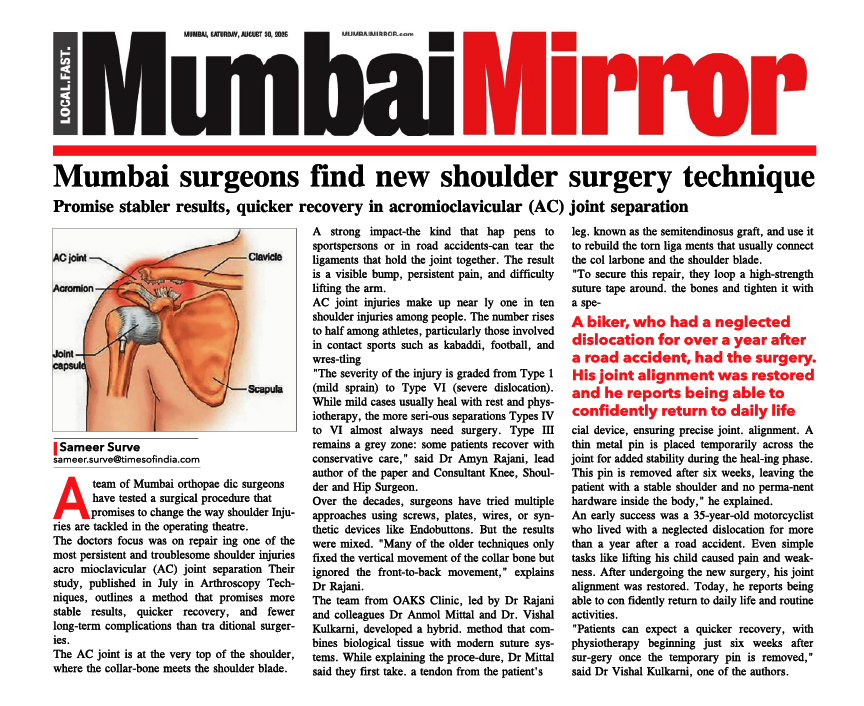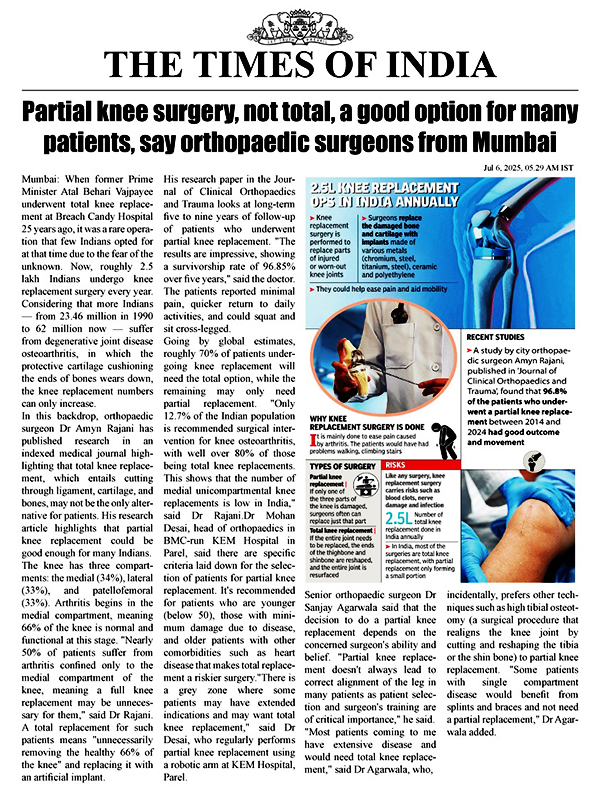The patella, commonly known as the kneecap, plays a crucial role in knee joint mechanics. It sits within the patellar groove of the femur and is integral to the function of the quadriceps muscle group. Patella baja and patella alta are conditions where the positioning of the patella is abnormal. Understanding these conditions, their symptoms, and treatment options is vital, especially for those consulting orthopaedic surgery specialists in Mumbai or joint replacement specialist in Mumbai.
What is Patella Baja?
Patella baja, also known as patella infera, is a condition where the patella sits lower than its normal anatomical position. This abnormal positioning can lead to restricted knee motion, increased stress on the knee joint, and pain.
What is Patella Alta?
Patella alta is the opposite condition, where the patella sits higher than normal. This can also cause knee pain and instability, as the patella may not track properly within the femoral groove during movement.

Symptoms of Patella Baja and Alta
Common Symptoms
- Knee Pain: Both conditions can cause anterior knee pain, particularly during activities that involve knee bending, such as climbing stairs or squatting.
- Limited Range of Motion: A lower or higher positioned patella can restrict knee movement.
- Swelling: Inflammation around the knee joint is common.
- Instability: A feeling of the knee giving way, especially in patella alta due to improper tracking.
- Crepitus: A grinding sensation when moving the knee.
Causes and Risk Factors
Causes
- Congenital Factors: Genetic predisposition can influence patellar positioning.
- Trauma: Injury to the knee, particularly fractures or ligament damage, can alter patella height.
- Surgical Complications: Post-surgical outcomes, such as those from knee replacements or ligament reconstructions, can result in patella baja or alta.
Risk Factors
- Age: Older adults are more likely to experience knee issues.
- Activity Level: High-impact sports can increase the risk.
- Previous Knee Injuries: Past trauma or surgeries can predispose individuals to these conditions.
Diagnosis
Diagnosis typically involves a combination of clinical examination and imaging studies.
Clinical Examination
- Physical Assessment: A detailed assessment of knee pain, range of motion, and stability.
- Patellar Height Measurement: Techniques like the Insall-Salvati ratio can be used to quantify patellar position.
Imaging Studies
- X-Rays: To visualize bone structures and patellar positioning.
- MRI: Provides a detailed view of soft tissues, including ligaments and cartilage.
- CT Scans: Useful in complex cases to get a three-dimensional view of the knee.
Treatment Options
Treatment varies based on the severity and symptoms of the condition.
Non-Surgical Treatments
- Physical Therapy: Strengthening and flexibility exercises to improve knee function.
- Bracing: Knee braces to provide stability.
- Medications: Anti-inflammatory drugs to reduce pain and swelling.
- Activity Modification: Avoiding activities that exacerbate symptoms.
Surgical Treatments
- When conservative measures fail, surgery may be considered. Consulting an orthopaedic surgery specialist in Mumbai can help determine the best approach.
- Arthroscopic Surgery: Minimally invasive surgery to correct patellar tracking issues or remove scar tissue.
- Realignment Procedures: Surgery to reposition the patella. This may involve tibial tubercle transfer or lateral release.
- Knee Replacement: In severe cases, partial or total knee replacement might be necessary. A joint replacement specialist in Mumbai, like Dr. Amyn Rajani, can provide expert care in these procedures.
Rehabilitation
- Post-treatment rehabilitation is crucial for recovery.
- Physical Therapy: A tailored program to restore strength and mobility.
- Gradual Return to Activities: Slowly reintroducing activities to prevent re-injury.
- Regular Follow-Ups: Monitoring progress and addressing any complications early.
Preventive Measures
- Regular Exercise: Strengthening the quadriceps and hamstrings can help maintain proper patellar alignment.
- Proper Technique: Ensuring correct techniques during sports and physical activities to avoid knee injuries.
- Weight Management: Maintaining a healthy weight to reduce stress on the knee joints.
FAQs
-
What are the primary differences between patella baja and patella alta?
Patella baja refers to a lower-than-normal patellar position, while patella alta indicates a higher-than-normal position.
-
Can patella baja or alta resolve without surgery?
Yes, mild cases can often be managed with non-surgical treatments like physical therapy, bracing, and medications.
-
How can I find a reliable orthopaedic surgery specialist in Mumbai?
Look for board-certified specialists with good reviews and a strong track record in knee surgeries. Dr. Amyn Rajani is a well-regarded option in Mumbai.
-
Is knee replacement always necessary for patella baja or alta?
No, knee replacement is typically considered a last resort when other treatments fail to alleviate symptoms.
-
How long is the recovery period after surgery for patella baja or alta?
Recovery can vary but typically ranges from a few months to a year, depending on the surgery's complexity and the patient's adherence to rehabilitation protocols.
Conclusion
Patella baja and alta are conditions that can significantly impact knee function and quality of life. Accurate diagnosis and appropriate treatment, whether conservative or surgical, are essential. Consulting with experienced orthopaedic surgery specialists in Mumbai, such as Dr. Amyn Rajani, ensures access to top-notch care and expertise. Early intervention, proper rehabilitation, and preventive measures can help manage these conditions effectively and improve patient outcomes.
For more information or to book a consultation with Dr. Amyn Rajani, visit OAKS clinic at Hughes Road, Mumbai r website www.dramynrajani.com or simply call on Clinic Number 91-88989 75355 / 91-22-23619137 to take the first step towards a pain-free future.





